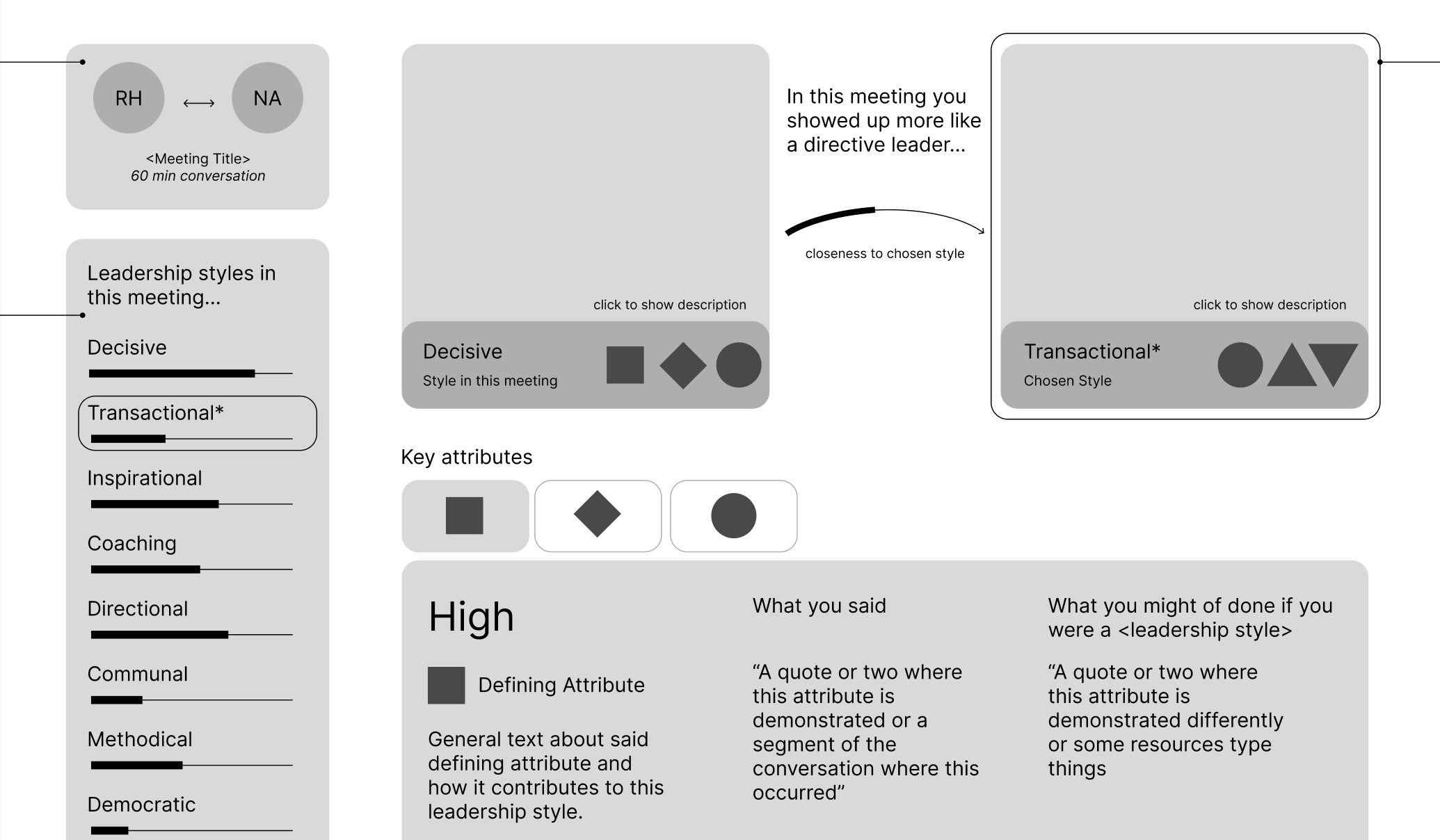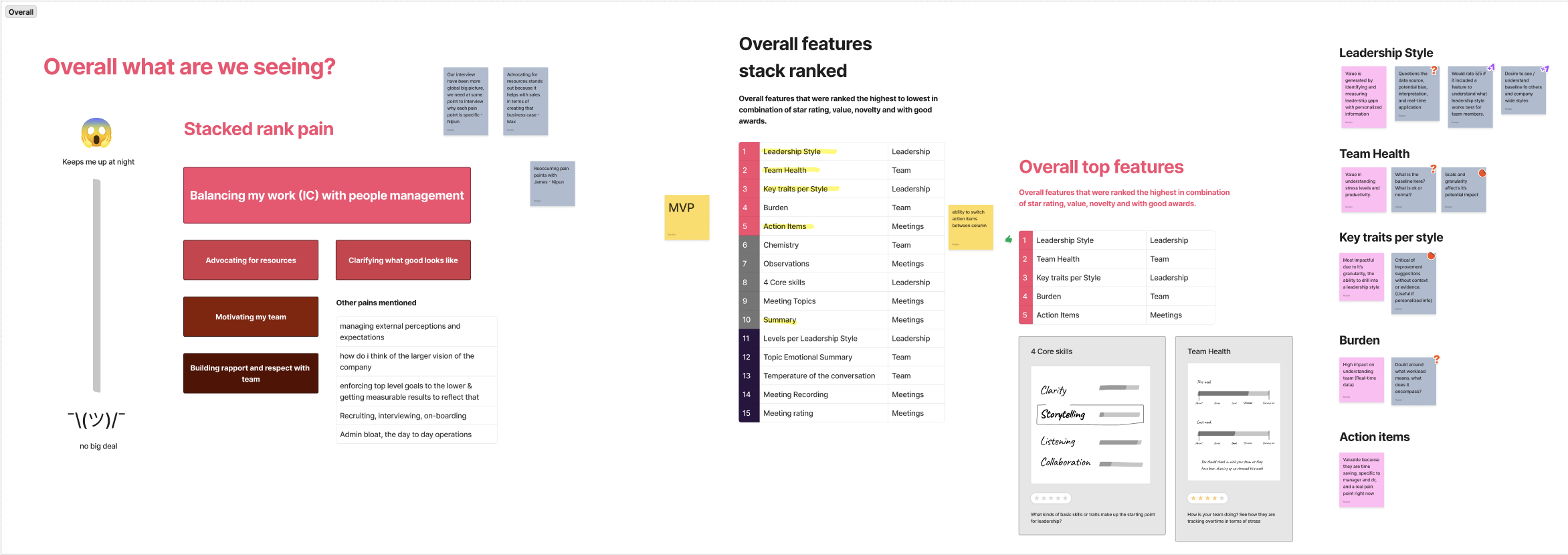CASE STUDY
Parafoil
Human-centred UX/UI & service design for a digital leadership analytics application start-up
Area
UX/UI, Digital Product
Role
Founding Designer
Plateform
iOS & Web-app
Employer
Parafoil
Impact
MVP & Alpha developed and launched
150+ beta user sign-ups
3 million raised in seed money
Challenge
How might we help frontline managers build healthier, more trusting relationships with their teams through data-driven leadership insights, creating more psychologically safe workplaces?
Context
Frontline managers face the daunting task of learning leadership on the job often with little to no training, pressures of deadlines, and limited access to feedback or mentorship. Parafoil enables frontline managers to collect feedback on how their leadership skills are impacting their team, giving them the instant data they need to tune in to a style that works best for them and for their team.
As the Founding Designer, I led all UX/UI research and design from concept to execution for the product MVP and Alpha launch. I worked closely with our Founding Engineer to create a user experience and user interface that simplified complex psycholinguistic data while being fast to implement. In developing Parafoil, I used HCD to guide a product market fit (PMF) approach.
Project Phases
Phase 1 - Problem discovery & customer Market finding
(3 months)
Phase 2 - Prototyping product service offerings & MVP
(6 months)
Phase 3 - Launching Alpha & iterating towards PMF
(6 months)
Problem Discovery & Customer Market Finding
Our start-up was co-founded upon the work I had done previously with psycholinguistics and systems change. After testing various hypotheses at different scales of implementation, we decided to narrow our scope to one on one conversations in digital environments. These situations worked best for the tech and also for the amount of trust and privacy required to gain insights from psycholinguistic data. What we were looking at in particular was not the content of what people talked about but rather how they talked with each other. In exploring the how, we could uncover data about people's leadership abilities and could reflect that back to them, allowing them to learn from their conversations.
Sketching out possible UI
As I was going through cycles of research and reporting out to the team, I was also sketching out ideas of product directions and features based on what I was finding out. Sometimes I would sketch and prototype by hand but mostly I would use Figjam to throw together a couple of ideas and share them with my team. Below are a couple sketches from the early days.
Understanding the current state of the system of leadership
During this phase, I explored various customer markets, interviewing potential customers to better understand their pains through semi-structured interviews. Through our initial research, we discovered that frontline managers in particular were experiencing the pain of leading in virtual environments,
Managers were feeling overwhelmed and underprepared for the transition into people management.
⅓ of folks in the workplace were quitting or quiet quitting because of bad managers
The state of mentorship, coaches and e-learning had become time consuming and too abstracted from the context of the managers relationships
Through subsequent thematic analysis, journey mapping, and value proposition testing, I refined the research into an ideal customer profile, a customer market, and a list of prioritized pain points with prevailing themes. I found that while the value propositions were compelling and were solving frontline manager’s pain points, they also revealed to me their worries around privacy and safety for themselves and their direct reports. This allowed my founding team, as product owners, to make informed decisions about the product and our business turning what we had learned into a strategic plan and product roadmap for the coming months.
Insight
Our core feature of psycholinguistic analysis methods and results for leadership growth was compelling but users found themselves being worried about privacy and safety. This created a clear path for my strategic research initiatives in the next phase.
Prototyping product service offerings & MVP
In order to address the insights from our research, I began to rapidly prototype different product directions based on our value proposition. Using our ICP pain points, I developed features and combined them in various ways to uncover what combination worked well as a product and service. I ran multiple wizard of oz sessions to test these feature sets which generated a prioritized list of features based on user pain and user stories that our team used to narrow our product direction and make an MVP.
Running a feature set refinement study
One of the research studies I ran was a short feature feedback study with 5 frontline managers from our ICP. I recruited and built out the research protocols in order to ascertain which features we should prioritize in building for our MVP. I began the 1 hour interview by having them warm up to the session with a couple easy questions and a fun, engaging stack ranking type mini game to validate our pain points. Then, I moved over to a feature set list that contained a wireframe sketch of a feature with a title and short description. After a brief discussion and 5 star ranking of desirability for each feature, we then placed them on a 2x2 with an x-axis of exists to novel and a y-axis of low to high value. I ended the session with a short awards ceremony to capture any remaining thoughts and feelings the participants had about our features. This helped us refine our product direction for MVP and prioritize what our engineer should work on next in terms of setting up the backend. Above is a snapshot from one of my sessions and a portion of the report-out.
Building out a fast-to-implement design system
Meanwhile, on the UI design side of things, I worked with my engineer to pick a UI library and AI builder to increase our MVP build. I chose shad/cn for its available library and my engineer chose builderio for its ease of code creation. Our process became designing in figma all of our UX/UI then translating it into code via builderio. Above are a couple more lo-fi wireframes for different product directions.
Below you can see a snapshot of our MVP, a single dashboard experience based on our leadership ontology that our other team members were developing. The dial on the right was built with the data science behind the leadership ontology in mind however after user testing it evolved into what you can see in the alpha version.
Addressing power, safety, and privacy
In engaging in research workshops and interviews with frontline managers, we began to understand how our feature implementations could foster the kind of health-promoting environment we were looking to create. Given the power imbalance between managers and direct reports, we focused on designing a product that was owned by the manager, for their personal use rather than a product owned by their company. In this way, we could prioritize transparent data use, user control, and non-punitive feedback mechanisms to ensure the tool empowered managers rather than surveilled them. We also began to create educational material for the managers to share with their direct reports as they would need their consent even though our app was only based on the manager’s language alone. From a technical standpoint this became our next great hurdle as we moved beyond our web-based app and into a native app solution.
Insight
While our main feature set was now compelling, the problem remained around collecting the requisite data to supply the language data for the features while supporting control and transparency for the manager and their data.
Side Quest
Leadership analysis for the Presidential debate side
As we developed our Alpha version, the presidential debate was taking place. We decided it would be a great way to test our leadership ontology and contribute to the larger discussion about leadership and democracy. Below is our report out…
Adding in a native app, launching our Alpha & iterating towards PMF
Working closely with our founding engineer, we decided that a native app, in addition to our web-based dashboard, would be an excellent solution to our problems of control, privacy and safety. Our new native app implementation would give direct access, control and visibility for the user over the app while being discreet as to not distract the manager from their meetings and relationship building with their direct report. We created a native app that would live in the menu extras bar which contained the necessary controls for the manager.
Refining the web app experience
After testing the MVP with users and real data, I began to better understand how to create a user interface that would lead to actionable, bite-sized information that our users could use to grow their leadership styles. I looked to sports related apps such as Strava, Nike run club, Garmin for inspiration because I began to see each meeting with your direct report almost like a workout in your particular leadership style. Therefore, the UI could take inspiration from these performance based apps to have a parallel performance based experience but for leadership. This manifested itself in the 5 past meeting cards that would indicate a high level overview of your recent “workout”, changing to green when you succeeded at displaying your goal leadership style. I worked closely with our data scientist to refine the user experience to be inline with the science behind each feature so as to not misrepresent the findings.
Impact
Building the native app created an experience that addressed their concerns by giving them direct & clear control over the app’s analysis features so that they felt safe and secure.
Reflection
This project taught me a lot about myself as a designer but also as a leader. Studying and researching leadership while actively leading research and design at a start-up was an incredible hands-on experience that I never imagined I’d have. I learned how to show up as a leader for a virtual team and the importance of trust in the path towards success. In designing an app for healthier relationships, it showed me the incredible level of care and detail that was needed to ensure the product experience was thoughtfully crafted for a health promoting experience. From the colours, to the layouts, every decision I made was in service to the user and their needs. Language and technology carry a lot of power in its ability to deeply affect healthy relationship building in workplace communities. The product continues on and is entering beta soon if you wish to check it out!




















